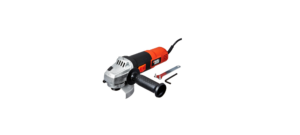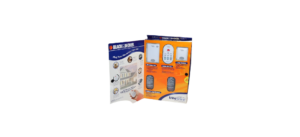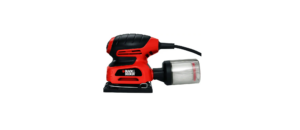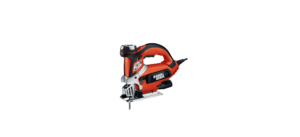Black & Decker KA88 Belt Sander
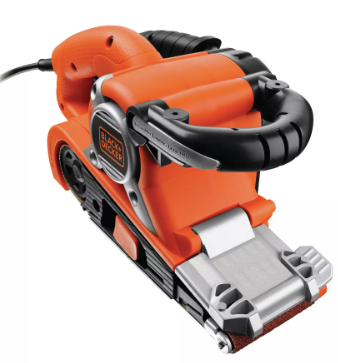
Introduction
A strong and effective tool for swiftly and cleanly sanding big surfaces is the Black & Decker KA88 Belt Sander. This belt sander’s 710-watt motor, dust collection system, and adjustable tracking make it perfect for both experts and do-it-yourselfers. Its small size makes it easy to use, and its variable speed control ensures accuracy. Regardless of whether you’re working with plastic, metal, or wood, the KA88 produces dependable performance and polished outcomes.
Intended use
Your BLACK+DECKER sander has been designed for sanding wood, metal, plastics and painted surfaces. This tool is intended for consumer use only.
Safety instructions
Work area safety
- Keep work area clean and well lit. Cluttered or dark areas invite accidents.
- Do not operate power tools in explosive atmospheres, such as in the presence of liquids, gases or dust. Power tools create sparks which may ignite the dust or fumes.
- Keep children and bystanders away while operating a power tool. Distractions can cause you to lose control.
Electrical safety
- Power tool plugs must match the outlet. Never modify the plug in any way. Do not use any adapter plugs with earthed (grounded) power tools. matching outlets will reduce risk of electric shock.
- Avoid body contact with earthed or grounded surfaces such as pipes, radiators, ranges and refrigerators. There is an increased risk of electric shock if your body is earthed or grounded.
- Do not expose power tools to rain or wet conditions. Water entering a power tool will increase the risk of electric shock.
- Do not abuse the cord. Never use the cord for carrying, pulling or unplugging the power tool. Keep cord away from heat, oil, sharp edges or moving parts. Damaged or entangled cords increase the risk of electric shock.
- When operating a power tool outdoors, use an extension cord suitable for outdoor use. Use of a cord suitable for outdoor use reduces the risk of electric shock.
- If operating a power tool in a damp location is unavoidable, use a residual current device (RCD) protected supply. Use of an RCD reduces the risk of electric shock.
Personal safety
- Stay alert, watch what you are doing and use common sense when operating a power tool. Do not use a power tool while you are tired or under the nce of drugs, alcohol or medication. A moment of inattention while operating power tools may result in serious personal injury.
- Use personal protective equipment. Always wear eye protection. Protective equipment such as dust mask, non-skid safety shoes, hard hat, or hearing protection used for appropriate conditions will reduce personal injuries.
- Prevent unintentional starting. Ensure the switch is in the off-position before connecting to power source and/or battery pack, picking up or carrying the tool. energising power tools that have the switch on invites accidents.
- Remove any adjusting key or wrench before turning the power tool on. A wrench or a key left attached to a rotating part of the power tool may result in personal injury.
- Do not overreach. Keep proper footing and balance at all times. This enables better control of the power tool in unexpected situations.
- Dress properly. Do not wear loose clothing or jewellery. Keep your hair, clothing and gloves away from moving parts. Loose clothes, jewellery or long hair can be caught in moving parts.
- If devices are provided for the connection of dust extraction and collection facilities, ensure these are connected and properly used. Use of dust collection can reduce dust-related hazards.
Power tool use and care
- Do not force the power tool. Use the correct power tool for your application. The correct power tool will do the job better and safer at the rate for which it was designed.
- Do not use the power tool if the switch does not turn it on and off. Any power tool that cannot be controlled with the switch is dangerous and must be repaired.
- Disconnect the plug from the power source and/or the battery pack from the power tool before making any adjustments, changing accessories, or storing power tools. Such preventive safety measures reduce the risk of starting the power tool accidentally.
- Store idle power tools out of the reach of children and do not allow persons unfamiliar with the power tool or these instructions to operate the power tool.
- Power tools are dangerous in the hands of untrained users.
- Maintain power tools. Check for misalignment or binding of moving parts, breakage of parts and any other condition that may affect the power tools operation. If damaged, have the power tool repaired before use.
- Many accidents are caused by poorly maintained power tools.
- Keep cutting tools sharp and clean. Properly maintained
Service
- Have your tool serviced by a qualified repair person using only identical replacement parts. This will ensure that the safety of the power tool is maintained.
- Power to the tool should always be supplied via residual current device with a rated residual current of 30mA or less.
Additional power tool safety warnings
- Hold the power tool by insulated gripping surfaces, because the sanding belt / sanding base may contact its own cord. Cutting a “live” wire may make exposed metal parts of the power tool “live” and could give the operator an electric shock.
- Use clamps or another practical way to secure and support the workpiece to a stable platform. Holding the work by hand or against your body leaves it unstable and may lead to loss of control.
- Contact with or inhalation of dusts arising from sanding applications may endanger the health of the operator and possible bystanders. Wear a dust mask and ensure that persons within or entering the work area are also protected.
- Thoroughly remove all dust after sanding.
- Take special care when sanding paint which is possibly lead based or when sanding some woods and metal which may produce toxic dust:
- Do not let children or pregnant women enter the work area.
- Do not eat, drink or smoke in the work area.
- Dispose of dust particles and any other debris safely.
- This tool is not intended for use by persons (including children) with reduced physical, sensory or mental capabilities, or lack of experience and knowledge, unless they have been given supervision or instruction concerning use of the appliance by a person responsible for their safety. Children should be supervised to ensure that they do not play with the appliance.
- The intended use is described in this instruction manual. The use of any accessory or attachment or performance of any operation with this tool other than those recommended in this instruction manual may present a risk of personal injury and/or damage to property.
Safety of others
- This appliance is not intended for use by persons (including children) with reduced physical, sensory or mental capabilities, or lack of experience and knowledge, unless they have been given supervision or instruction concerning use of the appliance by a person responsible for their safety.
- Children should be supervised to ensure that they do not play with the appliance.
Residual risks.
Additional residual risks may arise when using the tool which may not be included in the enclosed safety warnings. These risks can arise from misuse, prolonged use etc. Even with the application of the relevant safety regulations and the implementation of safety devices, certain residual risks can not be avoided.
These include:
- Injuries caused by touching any rotating/moving parts.
- Injuries caused when changing any parts, blades or accessories.
- Injuries caused by prolonged use of a tool. When using any tool for prolonged periods ensure you take regular breaks.
- Impairment of hearing.
- Health hazards caused by breathing dust developed when using your tool (example:- working with wood, especially oak, beech and MDF.)
Vibration
The declared vibration emission values stated in the technical data and the declaration of conformity have been measured in accordance with a standard test method provided by EN 60745 and may be used for comparing one tool with another. The declared vibration emission value may also be used in a preliminary assessment of exposure.
The vibration emission value during actual use of the power tool can differ from the declared value depending on the ways in which the tool is used. The vibration level may increase above the level stated. When assessing vibration exposure to determine safety measures required by 2002/44/EC to protect persons regularly using power tools in employment, an estimation of vibration exposure should consider, the actual conditions of use and the way the tool is used, including taking account of all parts of the operating cycle such as the times when the tool is switched off and when it is running idle in addition to the trigger time.
Labels on tool
The following pictograms are shown on the tool:
Warning! Tread the instruction manual reduce the risk of injury, the user must Electrical safety
Features
- On/off switch
- Lock-on button
- Adjustable handle
- Tension lever
- Retractable hood
- Centring knob
- Dust extraction outlet
Assembly
Warning! Before assembly, make sure that the tool is switched off and unplugged.
Fitting a sanding belt
Warning! Never use the tool without a sanding belt.
- Pull the tension lever (4) outward to release the tension on the sanding belt (8).
- Remove the old sanding belt.
- Place a new sanding belt over the rollers.
- Ensure that the arrow on the sanding belt points in the same direction as the arrow on the tool.
- Push the tension lever (4) inward to tension the sanding belt.
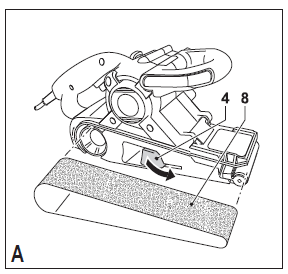
Adjusting the sanding belt tracking
- To ensure a correct tracking, the sanding belt must be centred over the rollers.
- Switch on the tool while holding it upside down.
- Turn the centring knob (6) as required until the tracking of the belt is centred over the rollers.
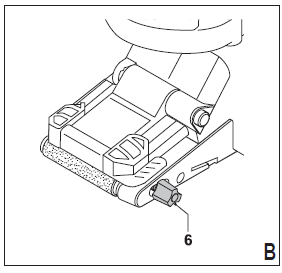
Adjusting the handle
The handle is adjustable to 3 positions.
- Unlock the handle (3) by pulling the locking handle (9) outward.
- Adjust the handle in the desired position.
- Lock the handle by pushing the locking handle inward.
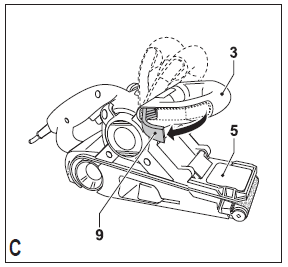
Retracting the hood
Warning! The hood can only be retracted when the adjustable handle is in the up position.
- Adjust the handle (3) in the straight-up position.
- Lift the hood (5) up.
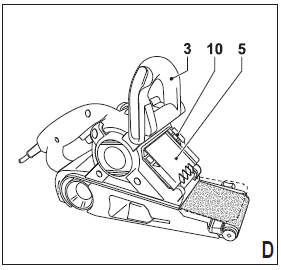
Fitting and removing the dust cassette
- Slide the dust cassette (11) over the dust extraction outlet (7).
- To remove the dust cassette, slide it off the outlet.
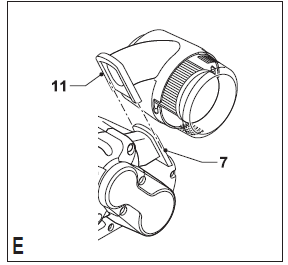
Connecting a vacuum cleaner
- Slide the adaptor (12) over the dust extraction outlet (7).
- Connect the hose of the vacuum cleaner to the adaptor.
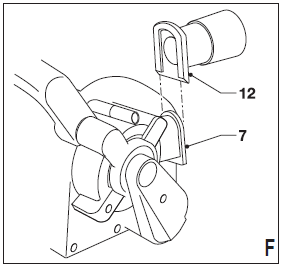
Use
Warning! Let the tool work at its own pace. Do not overload.
Switching on and off
For continuous operation, press the lock-on button (2) and release the on/off switch. To switch the tool off, release the on/off switch. To switch the tool off when in continuous operation, press the on/off switch once more and release it.
Emptying the dust cassette
The dust cassette should be emptied every 10 minutes of use.
- Remove the dust cassette (11) to the rear and off the tool.
- Remove the cover (13) by twisting it clockwise.
- Shake the cover to empty the contents counterclockwise until it locks into place.
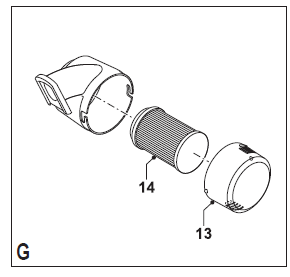
Cleaning the dust cassette filter
- The dust cassette filter is reusable and should be cleaned regularly
- Empty The Dust Cassette and describes above
- Pull the filter off the dust cassette
Hints for optimum use
- Always hold the tool with both hands.
- Do not exert too much pressure on the tool.
- Regularly check the condition of the sanding belt. Replace when necessary.
- Always sand with the grain of the wood.
- When sanding new layers of paint before applying another
- On very uneven surfaces, or when removing layers of paint, start with a coarse grit.
- Consult your retailer for more information on available accessories.
Accessories
The performance of your tool depends on the accessory used. BLACK+DECKER and Piranha accessories are engineered to high quality standards and designed to enhance the performance of your tool. By using these accessories you will get the very best from your tool.
Maintenance
Your tool has been designed to operate over a long period of time with a minimum of maintenance. Continuous satisfactory operation depends upon proper tool care and regular cleaning.
Warning!
- Before performing any maintenance, switch off and unplug the tool.
- Regularly clean the ventilation slots in your tool using a soft brush or dry cloth.
- Regularly clean the motor housing using a damp cloth. Do not use any abrasive or solvent-based cleaner.
Protecting the environment
- This product must not be Protecting the environment Should you find one day that your BLACK+DECKER product needs replacement, or if it is of no further use to you, do not dispose of it with household waste.
- Make this product available for separate collection. Separate collection of used products and packaging allows materials to be recycled and used again.
- Re-use of recycled materials helps prevent environmental pollution and reduces the demand for raw materials.
- Local regulations may provide for separate collection of electrical products from the household, at municipal waste sites or by the retailer when you purchase a new product.
- BLACK+DECKER provides a facility for the collection and recycling of BLACK+DECKER products once they have reached the end of their working life.
- To take advantage of this service please return your product to any authorised repair agent who will collect them on our behalf.
- You can check the location of your nearest authorised repair agent by contacting your local BLACK+DECKER office at the address indicated in this manual.
- Alternatively, a list of authorised BLACK+DECKER repair agents and full details of our after-sales service and contacts are available on the Internet at: www.2helpU.com
Technical data
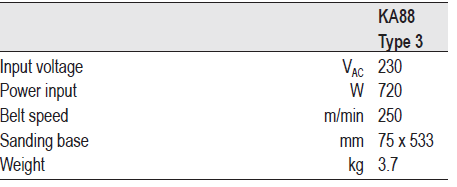
BLACK+DECKER
- Australia & New Zealand
- Stanley Black & Decker
- www.blackanddecker.com.au
- www.blackanddecker.co.nz
- Tel.1800 338 002 (Aust)
- Tel. 0800 339 258 (NZ)
Black & Decker KA88 Belt Sander Instruction Manual
FAQs
What is the KA88 belt sander’s power rating?
Its 710-watt motor offers sufficient power for sanding jobs.
What is the KA88’s sanding belt size?
It makes use of commonly accessible 75mm x 533mm (3-inch x 21-inch) sanding belts.
Is there variable speed control on the KA88?
Indeed, it has a variable speed control system for accurate sanding.
Is it possible to sand metal with the KA88?
Yes, it can sand plastic, metal, and wood if the right sanding belt is used.
Is there a dust collection system on the KA88?
Yes, it comes with a dust bag and a dust collection mechanism to keep your work area tidy.
